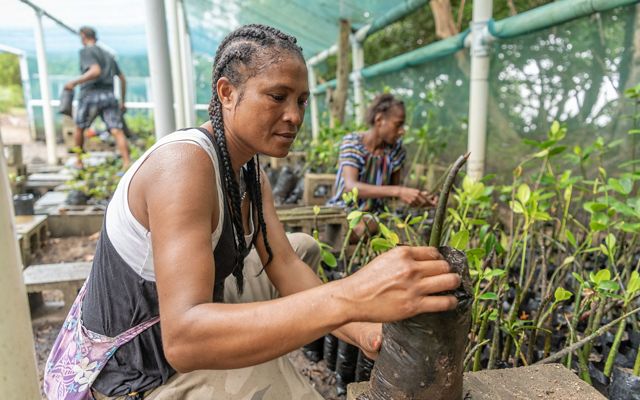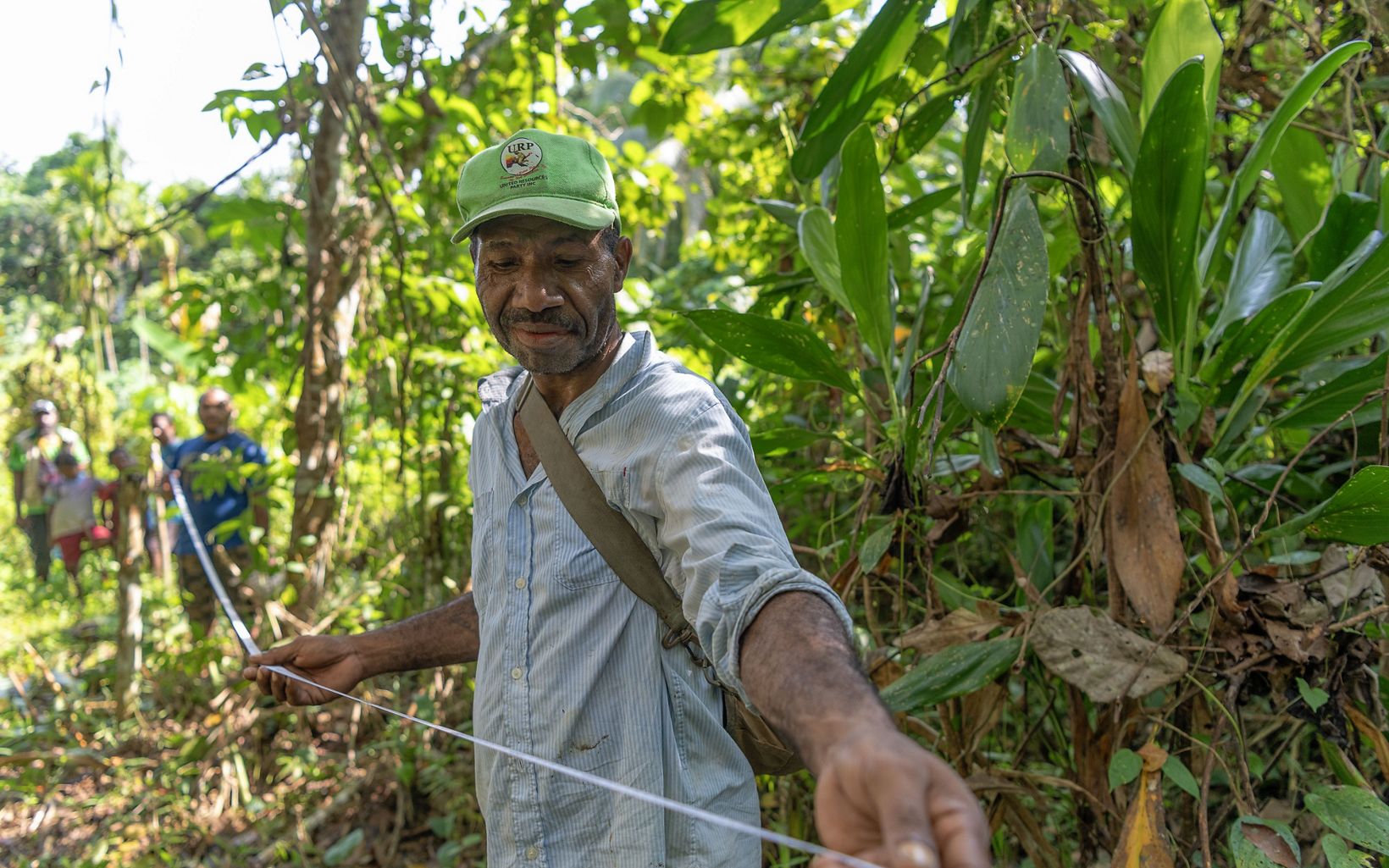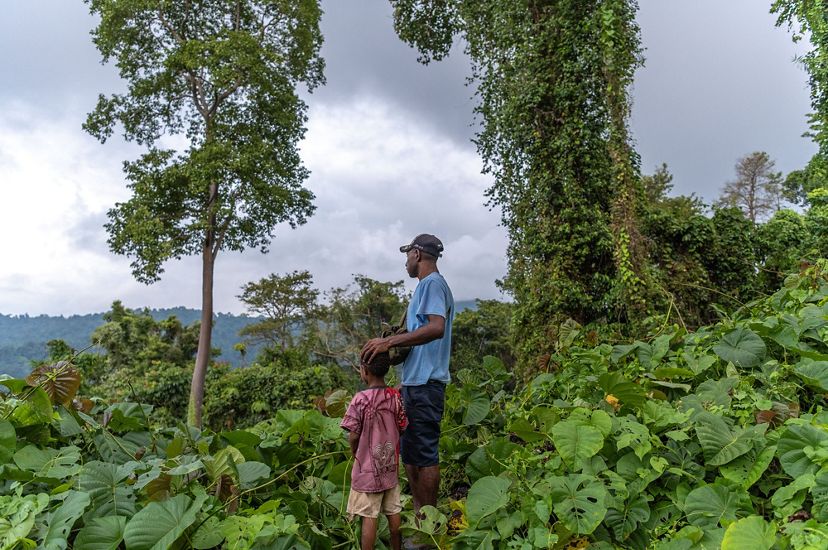
Mangrove Forest Mazzella Maniwavie, the program manager for Mangoro Market Meri, stands within a mature mangrove forest at Bautama near Port Moresby, Papua New Guinea. © Annette Ruzicka
Dulcie and Koivi Egu tend to hundreds of little black bags, each with a single mangrove tree sprouting from the top. The father-daughter duo started their nursery not long ago near Bootless Bay, outside Papua New Guinea’s capital city of Port Moresby. It’s part of a larger project to help regenerate the area’s lost shoreline mangrove trees. Meanwhile, hours away in the mountainside village of Simbukanam, Lawrence Micah is working with local communities to formalize land ownership maps that can be used to prevent loggers from encroaching onto their forested land, and to hold them accountable in court if they do. Though both efforts face uniquely different challenges, they are both trying to save the forests upon which their communities depend.
Papua New Guinea is home to about 12 million people, 1,000 distinct cultures and more than 850 languages, some with no linguistic relatives anywhere in the world. The nation’s human diversity is only matched by its ecology: The island of New Guinea boasts the third-largest tract of tropical rainforest in the world, and 30% of its flora and fauna are endemic. It’s home to a greater variety of vascular plants than any other island on the planet and 740 species of birds.
“Papua New Guinea is probably the most biologically and culturally diverse place on Earth,” says Richard Hamilton, The Nature Conservancy’s senior science and conservation advisor for the Asia-Pacific region. “It’s an amazing country.”
Papua New Guinea
-
12M
People
-
1000
Distinct cultures
-
850
Languages
-
30%
Of wildlife is unique to the island
-
3rd
Largest tract of tropical rainforest worldwide

It’s also a place where underregulated extraction industries—gas drilling, mining, logging and fishing—are beginning to pose grave threats to both the environment and traditional lifestyles that have persisted for perhaps tens of thousands of years. International companies are now interested in Papua New Guinea's resources, putting local people under new pressures.
But with these changes come opportunities to combine conservation with economic development at the community level. “Growing up in the highlands, I know firsthand how important healthy forests are for local people who directly depend on the environment to live,” says Ruth Konia, TNC's country program director. “I also know that without working hand in hand with communities, conservation here doesn’t work.”
Through two projects—one in an upland rainforest and the other in the mangrove forests—TNC is helping Papua New Guineans build a richer, greener future for themselves through their natural resources.
Conservation Incentives and Economic Opportunity
Mangrove forests can strike humans as somewhat unnerving. The trees’ prop roots tangle together in dense thickets, while the decomposing detritus that accumulates around them releases malodorous gases. And all that dark, still water provides perfect cover for snakes and saltwater crocodiles.
“When people look at the mangrove, they see somewhere that’s smelly, muddy or dirty,” acknowledges Mazzella Maniwavie, a scientist working on mangrove conservation for The Nature Conservancy in Papua New Guinea. “But mangroves are special, because they are able to grow in a place where no other tree can grow.”


A terrestrial plant that survives in salt water, mangroves are a sort of marvel. Acre for acre, mangrove forests can sequester three to five times more carbon than a terrestrial tropical forest. Mangroves also stabilize the coastline, providing a buffer against storm surges and flooding and preventing excess sediment from running into the sea, where it may smother coral reefs. They provide habitat for fish, reptiles and birds. And those are important to Papua New Guineans, which is why TNC is helping local communities lead the way in their conservation.
Since Maniwavie was born in 1987, Papua New Guinea’s capital, Port Moresby, has more than doubled in size; it’s now home to 400,000 people. In many ways, though, the nearby inlet known as Bootless Bay feels much the same as it did when she was a girl, tagging along on research expeditions with her father, a marine biologist at University of Papua New Guinea. “Every time I come here it connects me back to where I started,” she says.
But Bootless Bay has also changed. People have inadvertently killed mangroves by digging up their roots to collect blood worms, a valuable fish bait. Woodcutting for fuel and construction has also taken its toll, as has a decade of coastal development. Meanwhile, higher tides driven by climate change upset the balance between salt water and fresh water.

“It’s painful to watch something get degraded,” Maniwavie says, “especially if you know people don’t really understand the importance of it.”
Maniwavie is not simply watching, however. She leads Mangoro Market Meri, a program that encourages Papua New Guinean women (“meri”) to be stewards of the country’s mangroves. Founded in 2016 at a TNC conference that brought together women from across the region, the program connects communities with economic opportunities that let them benefit from nearby mangrove forests without depleting them. At present, that includes sustainably harvesting mud crabs, crustaceans the size of a dinner plate that are in high demand at area seafood markets. The program hopes to link local people with carbon credit initiatives, which could infuse this developing region with global cash. “That provides an incentive to conservation,” Maniwavie says.
It’s also vital that women be at the center of the effort. Throughout the Asia-Pacific region, women make up a majority of the population using mangroves. They have a wealth of knowledge about the species of mangrove in their areas and the health of the ecosystem generally. “But then there’s the reality that many communities in Papua New Guinea that you go to, it’s a patriarchal society, and women are not necessarily part of the decision-making process,” Maniwavie says. “So we work with communities to empower the women.”
Quote: Cosmas Apelis
We’ve always looked at conservation, conservation, conservation, but you have to take people into consideration, because they are the stewards of the land.
Three hundred miles north of Bootless Bay in mountainous Madang Province, TNC is helping rural people organize to assert their land rights and protect a very different sort of forest.
“We’ve always looked at conservation, conservation, conservation,” says Cosmas Apelis, who leads TNC’s efforts here. “But you have to take people into consideration, because they are the stewards of the land.”
Madang is a place where people’s lives are not much different from their ancestors’. “The forest is our livelihood,” says Lawrence Micah, who has lived his entire 50 years in the village of Simbukanam. “It’s our food, it’s our hospital, and everything.” He is the chairman of the Gildipasi Conservation Group, an association that represents local villages to give them a stronger collective voice in regional issues. He has witnessed virgin forest cut down by companies that had dubious reputations and even more dubious logging permissions. His goal is to see local land-use rules formalized and recognized by the provincial government.






He, TNC and other conservation groups are working with community members to develop land use plans that preserve the forests for the long term. With little involvement from the regional or national governments, they abide by customary property rights, under which the people living nearby are the land’s owners and caretakers.
However, resisting logging companies' well-funded operations requires local people to stand together—and get creative. Apelis relates the story of a community that recently discovered a logging operation had encroached illegally onto its land.
“It came to a head where they had had enough,” Apelis says. “The company had left all the logging machinery, all the trucks and all that, lined them on the highway. So the people came and took all the keys. And so the police had to come in, and the provincial government had to step in, because people said, ‘We are not going to give back the keys until the government comes and explains why it isn’t doing monitoring and enforcement.’ They put their foot down, and that’s when they got respect.”

The Nature Conservancy aids local communities by lending surveying expertise as they formalize their customary land rights and record the locations of critical resources like streams. The organization is also supporting local people in their campaigns to arrange community-wide conservation pledges. Sometimes local leaders disagree about conservation goals, but the discourse among neighboring communities often makes for stronger resolutions in the end.
Micah is optimistic that the agreements and some new farming prospects will offset the pressure from outside logging companies. The Conservancy is also connecting people with sustainable economic opportunities—it’s easier to turn down a logging company’s offer to buy your timber rights when you have an alternative source of revenue. New village-based savings and loans have helped entrepreneurs build businesses. Some communities are pursuing organic certification for cash crops like cocoa, coconuts and vanilla. Eventually, TNC also hopes to link communities to nature-based solutions such as the international carbon market, which will help them generate income by conserving their forests.
“Conservation should be a development tool,” Apelis says. In Papua New Guinea, that’s a theme that runs from the mountains all the way to the sea (“ridges to reefs,” as many of TNC’s Pacific staffers like to put it). “We build the capacity for people to do conservation, but at the same time, we help empower them economically.”

“We know what mangroves bring into our lives.”
In Bootless Bay, one of the businesses that Mangoro Market Meri supports is Karikari Mangrove Nursery, which Dulcie Egu and her father, Koivi, founded last year after receiving training through TNC. With guidance from Maniwavie, they and their mostly female employees are growing mangrove saplings. The community-based nurseries in Bootless Bay have helped replant more than 3,000 mangroves. Over the next decade, Mangoro Market Meri, which buys the baby mangroves from the nurseries for about a dollar each, aims to plant at least 200,000 more.
“We live here, and we know the importance of mangrove,” Dulcie says, standing beside a greenhouse that shelters hundreds of propagules. “We know what mangroves bring into our lives. ... When we cut it down today, if we don’t replace it, then in the future our children will suffer.”
In addition to serving as a source of food and wood, Dulcie explains, mangroves protect against floods. She shrugs: Helping them just makes sense.
It makes Maniwavie proud. As women plant mangroves in Bootless Bay, and as mountain villages rally around preserving the tropical rainforest, Papua New Guineans take seriously their role as caretakers. “It gives me hope,” Maniwavie says. “The fact that the community takes ownership and the initiative to do the restoration work by themselves, it’s changing the tide. Nobody can do it better than themselves.”
About the Creators
Writer: Amy Crawford is a freelance writer based in Michigan. She has also written for Smithsonian magazine, The Boston Globe and CityLab.
Photographer: Annette Ruzicka is an award-winning photojournalist based in Melbourne, Australia, who specializes in nature and its connection to human cultures.











